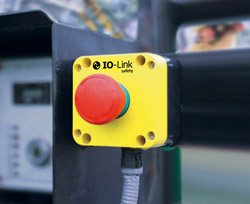
Posted to News on 11th May 2017, 14:39
IO-Link Safety specification ready for implementation
With the release and publication of the IO-Link Safety specification by the IO-Link Community and the successful concept assessment by the TUV SUD, nothing else stands in the way of IO-Link Safety's implementation in systems and devices.

Like IO-Link, IO-Link Safety is fieldbus and system independent. This is achieved through conversion of the many safety protocols available on the market to IO-Link Safety in the master. The IO-Link Safety Devices therefore remain available worldwide. As there are considerably more device types (already more than 4000) than IO-Link masters, the advantages are obvious. To open a new market or a new system for IO-Link Safety, all that is necessary is to develop a corresponding IO-Link Safety master. All existing IO-Link Safety devices can then be used without modification.
The time and effort for configuring IO-Link Safety is said to be minimal. Authentication is derived from the assignment to the master port, and the monitoring time is set automatically for each device. As with IO-Link, devices can be replaced without using an engineering tool. A replaced device is automatically assigned the stored parameters of its predecessor after startup. Furthermore, the authentication avoids confusion and manipulation.
A significant challenge is open and secure parameterisation of safety devices. IO-Link Safety devices always have an IODD device description that contains the complete communication properties, identification, parameterisation and diagnosis. However, the applicable standards require a 'dedicated safety tool' to rule out manipulation. Therefore, a software interface exists for integrating the dedicated tools associated with the devices into the IO-Link engineering tools. The Device Tool Interface (DTI) has been kept very simple and ensures that integration into the existing IO-Link engineering tools does not pose a problem and that safety-related device software can be easily adapted and used further on the device side.
In the process, it is important that the package consisting of the IO-Link Safety device, IODD, and the 'dedicated tool' can be used globally in all system environments without modification. Users can therefore access a broad range of devices, regardless of what automation system they use or in what industry or region they work.
On the basis of the existing specification, manufacturers can now begin to integrate IO-Link Safety into their systems. The test specification, the test system, and the certification are being developed in parallel. Although products are not yet expected in 2017, a rapid rollout is anticipated subsequently, especially in Asia and Europe.
More information about IO-Link can be found at www.profibus.com/technology/io-link.
Want the latest machine building news straight to your inbox? Become a MachineBuilding member for free today >>

















